| Autogyro Concept JT-9 and JT-9T (Trainer) Updated in May, 2009 |
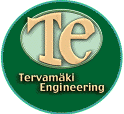 |
The
JT-9 autogyro concept is my newest design and 3D modeling project. The
purpose of the project was to evaluate a tractor gyro design with good
aesthetics and performance with fairly low power. This project was also
a kind of return to my oldest dreams of autogyros, see my autogyro sketch from the late fifties!
Why a tractor? Pusher gyros have two main benefits, good helicopter like visibility from the cockpit and a fairly simple load carrying structure, with all main loads, engine, pilot, fuel tank and main landing gear attached to the rotor mast. The biggest drawback of the pusher gyros is the limited space (between keel tube and rotor) for an efficient propeller.
Silent! It is here that the tractor gyro shines. You can use an airplane-like propeller diameter offering a much improved efficiency. JT-9 could utilize propellers up to 1.7 m diameter allowing the use of a slow turning, silent prop. A suitable engine would be the Japanese HKS 700 or the Hexadyne Aviation P60 both delivering about of 65 at 2400 rpm.
Less work. Another goal in designing the JT-9 was to reduce the number of composite parts which involve the rather laborious method of making the plug and mold. The fuselage of the JT-9 is of normal steel tube construction covered with dacron fabric. Yes, there are still a number of composite parts to be made, including rotor blades, tail surfaces, engine cowling, landing gear and various fairings. Engine cowling and fairings could be made with the "Burt Rutan method" without a mold while landing gear and tail surfaces would require a simple wood/sheet metal mold. Seat and floor structure could be made of 10 mm composite honeycomb sheets bonded together with glass/epoxy mix. Rotor blades are of the same composite construction as in JT-5 autogyro.
Another time-saving item in the JT-9 is the canopy. It could be bent and cold-formed from 3 mm polycarbonate sheet. The backwards sliding canopy offers the possibility to taxi and fly slowly with the canopy open, a benefit in a hot climate.
In May 2009, while testing the new formZ animation features, I made a JT-9 animation where the machine flies over Malmi airport in Helsinki. Take a look at this animation JT9raimii.
Why a tractor? Pusher gyros have two main benefits, good helicopter like visibility from the cockpit and a fairly simple load carrying structure, with all main loads, engine, pilot, fuel tank and main landing gear attached to the rotor mast. The biggest drawback of the pusher gyros is the limited space (between keel tube and rotor) for an efficient propeller.
Silent! It is here that the tractor gyro shines. You can use an airplane-like propeller diameter offering a much improved efficiency. JT-9 could utilize propellers up to 1.7 m diameter allowing the use of a slow turning, silent prop. A suitable engine would be the Japanese HKS 700 or the Hexadyne Aviation P60 both delivering about of 65 at 2400 rpm.
Less work. Another goal in designing the JT-9 was to reduce the number of composite parts which involve the rather laborious method of making the plug and mold. The fuselage of the JT-9 is of normal steel tube construction covered with dacron fabric. Yes, there are still a number of composite parts to be made, including rotor blades, tail surfaces, engine cowling, landing gear and various fairings. Engine cowling and fairings could be made with the "Burt Rutan method" without a mold while landing gear and tail surfaces would require a simple wood/sheet metal mold. Seat and floor structure could be made of 10 mm composite honeycomb sheets bonded together with glass/epoxy mix. Rotor blades are of the same composite construction as in JT-5 autogyro.
Another time-saving item in the JT-9 is the canopy. It could be bent and cold-formed from 3 mm polycarbonate sheet. The backwards sliding canopy offers the possibility to taxi and fly slowly with the canopy open, a benefit in a hot climate.
In May 2009, while testing the new formZ animation features, I made a JT-9 animation where the machine flies over Malmi airport in Helsinki. Take a look at this animation JT9raimii.
Click the pictures
to view the bigger size!
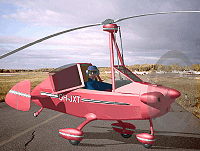 A magneto check |
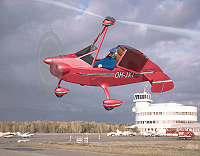 Stunt flying, see animation! |
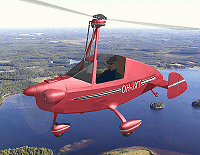 Over the Finnish lake country. |
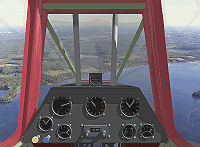 Forward view from the cockpit |
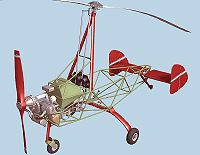 Engine, fuel tank and instruments |
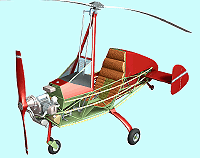 Seat and partial covering |
Many persons have contacted me in requesting a 2-place machine. These requests also came from Finland. The lack of a suitable engine model to start with prevented me from starting the modeling job. To create again another new engine model myself was just too big a job.
But then two friends of mine, Seppo Vihavainen and Markku Hakamäki, started a 2-seat Little wing autogyro project in Finland with the British Wilksch Airmotive WAM 120 diesel engine delivering up to 120 hp. I was invited to be the inspector in this project and got the WAM 120 information on this occasion. An e-mail contact to Wilksch Airmotive finally resulted me to receive the WAM 120 engine model on a CD in parasolid format. The problem was that my modeler, the formZ does not import parasolid data but we finally succeeded in converting the complete engine file into STL-format which was easily read by formZ. Having now a modern 2-cycle diesel engine model I quickly started the modeling job of a 2 seat JT-9T version.
CG position
The CG position in the single seat model is estimated and would require a more complete study for best possible rotor mast angle. Fine adjustment of the CG position could be made later on with the battery placement. For the two seater version I also made complete weight and CG calculations and the placement of the various components and main landing gear should be OK.
Prerotator:
The type of prerotator is problematic in a tractor gyro since mechanical drives would add another obstruction to the pilots view. Electric, hydraulic and pneumatic drives are possible. An electric one would be the easiest to make since there is an alternator and a battery provided. A minimum of .3 hp would be required for prerotation. A small and powerful starter engine could do the job and may possibly be found in some outboard motors?
Click the pictures
to view the bigger size!
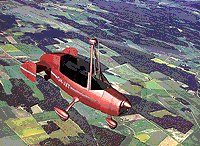 The JT-9T version over Punkalaidun, my birthpace. |
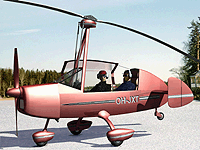 JT-9T-Trainer. Warm cockpit in winter, yes! |
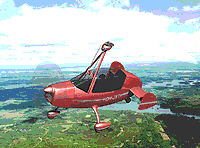 Horizontal stabilizer is important in preventing PIO in gusty conditions. |
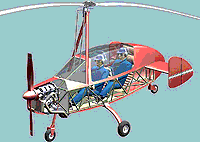 Tandem seating. |
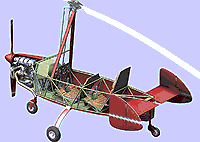 Steel tube structure & Controls |
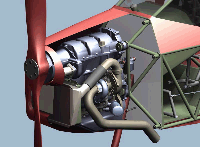 Wilksch WAM 120 diesel engine |
| Specifications: | JT-9 | JT-9T Trainer |
| Rotor Diameter Rotor Blade Chord Airfoil Prerotator |
7 m 180 mm NACA 8-H-12 Electric |
8.2 m 250 mm NACA 8-H-12 Electric |
| Fuselage Length Width Height |
3.8 m 1.8 m 2.4 m |
4.6 m 2.05 m 2.95 m |
| Empty Weight Gross Weight Useful Load |
180 kg 320 kg 140 kg |
300 kg 500 kg 200 kg |
| Powerplant Propeller Diameter |
HKS 700 65 hp/2400 rpm 1.6 m |
WAM 120 diesel 120 hp 1.8 m |
| Max rate of Climb Max Level Speed Economical Cruising Range |
3 m/s 160 km/h 130 km/h 400 km |
3.5 m/s 160 kmh 130 kmh 450 km |
Although
I have not made the JT-9 drawings available for homebuilders some
people have promised to build the JT-9. Michel (Michelcros@aol.com) is
the first who has done the job. His machine looks great.
"Voilà une machine réalisée sur votre idée. Il vole bien et me donne entiere satisfaction. Merci pour l'inspiration du modéle. Amicalement."
Michel
Alta Vista translation: "Here is a machine produced on your idea. It flies well and gives me entiere satisfaction. Thank you for the inspiration for the modell". Michel
"Voilà une machine réalisée sur votre idée. Il vole bien et me donne entiere satisfaction. Merci pour l'inspiration du modéle. Amicalement."
Michel
Alta Vista translation: "Here is a machine produced on your idea. It flies well and gives me entiere satisfaction. Thank you for the inspiration for the modell". Michel
Rotor Diameter: 7,20 m
Blade Chord: 0,20 m,
Blade Airfoil: NACA 23012
Electric Prerotator
Length: 3,70 m
Width: 1,80 m
Height: 2,75 m
Empty Weight: 150 kg
Engine: Arrow 500, 2 cycle, 65cv
Propeller Diameter: 2 m
Fuel Tank capacity: 57 liters
Endurance : 5 hr+
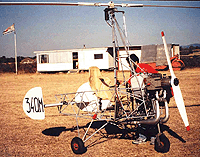 |
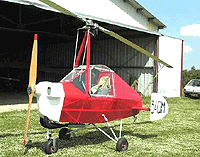 |
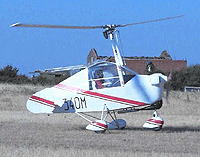 |
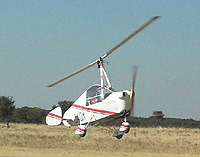 |
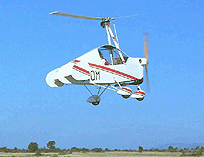 |
While the 3D model would allow me to derive JT-9 drawings fairly easily, no drawing set is available at the moment except the four A1-size drawings below in pdf-format (see below).
Downloads:
1) A Screen Background picture for 19" screens, Stuntfly.jpg, 124 kb
2) Another Screen Background Picture, Winter.jpg, 124 kb
3) A tricycle JT-9 three-view
4) A Taildragger JT-9 three-view
5) JT-9 Airframe details
6) JT-9 Control system principles
7) JT-9T Drawing
Comments are welcome. Send me e-mail to jtki(at)icon.fi
Comments:
I admire
your work a lot. I wish there were plans available for the JT-9.
Robert W. Rominger, Newnan, GA, USA
I much admire your work and website but do you have any plans available for an autogyro, one or two seat?
Mike Goodrich
Its me again the guy that has been after you to put out a set of plans for what I think is the smartest design i have seen.
I was able to get your sample drawings printed. I have been looking them over and I guess I am wishing I could get some more views and more close up drawings of your joy stick and the way you planned to build your tail and your linkages for it and your steerable nose wheel.. I just can't get your machine out of my head.
Gary Bartczak
WOW !! Very impressive. Its nice to have someone just getting on with installation work of WAM 120 without me having to help. Great stuff ! I have no problem with the links on your web page and it looks like a very interesting project. I wish you all success with it.
Martin Long
Wilksch Airmotive Ltd
I've had the pleasure of exploring your website and discovering the magnificent gyroplanes you're designing. Congratulations! I think you've really got something here.
Karaya Aircraft, New Zealand
j'ai enfin trouvé le concept idéale de mon gyro de rêve sur votre site Internet. votre JT-9T TRAINER, car assez simple et classique de construction, compacte, une ligne harmonieuse et surtout équipé d'un petit moteur diesel moderne compacte et léger, ce serai le gyro "PARFAIT".
Cordialement Didier
I live in MIlano, Italy. Let's say...your brain is a volcano! Thanks for brainstorming for us all... My question is: how may I get plans to build the JT9 and/or the JT11 rotorcraft? As I'm a quite well proven aircraft home-builder, it could be sufficient also a not well finished set of drawings. May I get plans of such beautiful birds?
Pierre Marcucci
Robert W. Rominger, Newnan, GA, USA
I much admire your work and website but do you have any plans available for an autogyro, one or two seat?
Mike Goodrich
Its me again the guy that has been after you to put out a set of plans for what I think is the smartest design i have seen.
I was able to get your sample drawings printed. I have been looking them over and I guess I am wishing I could get some more views and more close up drawings of your joy stick and the way you planned to build your tail and your linkages for it and your steerable nose wheel.. I just can't get your machine out of my head.
Gary Bartczak
WOW !! Very impressive. Its nice to have someone just getting on with installation work of WAM 120 without me having to help. Great stuff ! I have no problem with the links on your web page and it looks like a very interesting project. I wish you all success with it.
Martin Long
Wilksch Airmotive Ltd
I've had the pleasure of exploring your website and discovering the magnificent gyroplanes you're designing. Congratulations! I think you've really got something here.
Karaya Aircraft, New Zealand
j'ai enfin trouvé le concept idéale de mon gyro de rêve sur votre site Internet. votre JT-9T TRAINER, car assez simple et classique de construction, compacte, une ligne harmonieuse et surtout équipé d'un petit moteur diesel moderne compacte et léger, ce serai le gyro "PARFAIT".
Cordialement Didier
I live in MIlano, Italy. Let's say...your brain is a volcano! Thanks for brainstorming for us all... My question is: how may I get plans to build the JT9 and/or the JT11 rotorcraft? As I'm a quite well proven aircraft home-builder, it could be sufficient also a not well finished set of drawings. May I get plans of such beautiful birds?
Pierre Marcucci